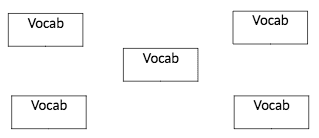Curriculum classes in the EPIK program will likely have 20-30 students, a mixed range of English proficiency, and limited space for desk rearrangement/movement.
NETs are encouraged to supplement and/or replace textbook activities with their own while bearing the following in mind:
-
-
-
- The practice stage has students working as a class or in large groups and has them drilling the material through the various styles of repetition.
-
-
As these activities will be teacher-guided, NETS should be wary of having excessive teacher-talk-time (TTT).
-
-
-
- The production stage has students working in smaller groups, where they have developed sufficient proficiency with the targets to become self-regulatory.
-
-
Although these activities have students transforming/manipulating the target language, there will be inevitably some overlap with the practice stage depending on how the NET chooses to implement the activities.
-
-
-
- TPR activities will be somewhat difficult to incorporate into curriculum classes, given the number of students and likely limited space to move around.
-
-
“Fun” activities can still be devised, but NETs need to think of the logistics (where students will be, if they need to move their chairs/bodies/books to play, etc.) before implementing the game.
About the Author: Tania Sanclemente completed the Advanced 120-hour TESOL Certificate program and the 20-hour Practicum. She spent two years in South Korea working as a public school teacher and provincial coordinator.
Practice Stage Activities for EPIK Classes:
1. Pass the Ball
Materials: ball, music (optional)
This game works brilliantly if you have some effective classroom management techniques already in place.
The game is simple: a ball (or two) is passed among students until the teacher stops the music.
The student(s) with the ball engages in the target question/answer, and the game restarts.
To modify the game so that all students are actively involved, have them chant/repeat the vocabulary words (instead of using a background song) until the teacher says stop.
Advantages:
-
-
-
- Low-prep and does not require technology
- The teacher can make the repetition/vocab chanting more difficult every few turns so that the students without the balls are still actively involved. Additionally, more balls can be added to the rotation so that more students are engaging with the target question/answer.
-
-
Disadvantages:
-
-
-
- Even with a very squishy ball, this game poses a safety hazard if the object is “whipped” around instead of softly tossed.
- The teacher is watching the class as the game proceeds so they can “see” the student that will have the ball when they yell “stop.” Although this may be good for selecting specific students that you want to participate in, many students will find this method unfair.
-
-
My personal adaptation was to have a PPT of timers going off at random intervals (5 sec, 15, sec, 20 sec, etc.), and this way students were kept on edge. I disguised the timers under “bomb” images and added background ticking music to add to the suspense.
Read: The Best TESOL Certification for South Korea
2. Slap Game
Materials: target words written on small cue cards, one set of words per each group.
Organize your students into either group of three/four people.
Present each group with a set of cards, containing the vocabulary words (to make the game easier, you may include duplicates of each word).
The teacher calls out a word, and students must quickly find the card containing the target word.
Advantages:
-
-
-
- This is a high-energy game that will get most students excited.
- Because it has students working in groups, members will be able to monitor each other if someone makes a mistake (and yes, they will definitely call each other out for any errors).
- Once students have an idea of the game, you may get them involved in the calling out of the vocabulary word so as to increase their excitement towards the game. Note: these people, however, would not be able to participate in that round of “card slapping”.
-
-
Disadvantages:
-
-
-
- This activity takes a lot of preparation; even if students were to write down the vocabulary themselves, it would still take up a lot of time.
- Unless you have access to mini-whiteboard/laminated cards, you will be wasting a lot of paper.
- Due to the nature of the game, there is a small risk of hand injury when going for the cards.
- The game can get chaotic if the teacher does not have effective classroom management techniques.
- Unless your cards have pictorial drawings in addition to the written word, you are assuming that all students are able to read (which will not be the case, especially in the elementary school grade 3-5 range).
-
-
Read: The Best TESOL Course for k-12 Teachers
3. Order Memorization

The teacher writes the target words on the board and reviews the pronunciation for each.
To demonstrate how the game works, draw an arrow connecting two vocabulary words (e.g. top-left word to bottom right word).
Have students repeat the words in order, and then draw another arrow. Have students repeat the words, beginning with the first vocabulary word.
If this is the first time you’re playing the game with your students, then I suggest drawing a third arrow before erasing them and having students attempt to recall the order.
Because this is a practice stage activity, it is important to keep the repetitions to large groups. There many ways to change this up though; entire class repetition, boys only, girls only, people wearing ___ color, etc.!
Advantages:
-
-
-
- This activity is a basic mechanical repetition activity, but it is disguised as a “game” (and one that forces students to be attentively paying attention the entire time)
- The difficulty of this game can be easily changed: to make it harder, you may either increase the number of vocabulary words used or the amount of “arrows” used to connect the words. To make it simpler, you can either do the opposite to the aforementioned or, for the lowest level of complexity, write the words in a linear fashion and erase one at a time as students recall the words in sequence.
- Low-prep and doesn’t require technology
-
-
Disadvantages:
-
-
-
- No association is made with the word’s meaning unless action is associated with each vocabulary word
- The NET must be able to remember the order of the words, without fail. If you mess up the order or second-guess yourself at any point, the mood will instantly turn against you!
-
-
Read: Find TESOL / TEFL Jobs in South Korea
Production Stage Activities for EPIK Classes:
4. Partner Dice Game

Pictured: unfolded cube
Give an unfolded cube to each student.
Have them fill in each square with a target word or expression.
Once the boxes have each been correctly filled in, have students fold them into a 3D cube and tape it such that the shape is held.
Students take turns tossing their paper dice on the table and make a sentence with the word/expression it has landed on.
Advantages:
-
-
- This is a speaking activity that allows students to incorporate some writing as part of the preparation process
- This activity can be adapted for any target word/expression
-
Disadvantages:
-
-
- If the dice are not laminated, then this will not be an activity that can be done often due to the amount of paper needed
- This is a low-energy activity unless some incentive is added to the game (e.g. partners play rock-paper-scissors after each round and keep a tally of the score)
-
Read: Is There a Difference Between TEFL and TESOL?
5. Whisper Game
Materials: Vocabulary words/expressions written on cue-cards
Students are arranged into groups containing four – seven members.
They are arranged so that they are in a single file, lined up one behind the other, and facing the front of the class.
The team member closest to the back of the classroom is to pick up a cue-card containing an expression, run back to their line, and whisper it to the person in front of them.
This whispered word (similar to broken telephone) is passed up to the front of the class, where the last student must either write the word on the board or repeat the word to the teacher.
The fastest team (with the correct answer) wins a point, and the “runner” now goes to the front of the line and everyone else shifts down a position.
Advantages:
-
-
-
- This activity is integrative as it encompasses all four skills (speaking, listening, reading, writing)
- As this activity is a “race”, it is a very high-energy game
-
-
Disadvantages:
-
-
-
- In order to get students into a line (and make sure that all teams have the same starting and finishing point), some space for movement will be necessary.
-
-
Additionally, if the teacher has not pre-chosen the groups, this will create unnecessary downtime.
6. Jumbled Sentences
Materials: typed questions (optional), scissors per each student/pair of students
As the name denotes, this is an activity where students must correctly reorder jumbled sentences.
In order to make this activity both more active and a “true” production activity, the teacher may ask students to make the sentences themselves.
Once the sentences have been made, these can be cut up and scrambled.
In cases where there are multiple sentences being cut/mixed at one time, the students are encouraged to number the back of each word to avoid confusion (e.g. each word from question one should have the number one written at the back before being cut up).
To increase the difficulty, students can exchange their sentences and reorder the examples written by another classmate.
Advantages:
-
-
- This game can be adapted for any target expression or vocabulary (in the case of single vocab words, each individual letter can be cut)
- This game can be repeated for as many times as the teacher deems fit through the classmate-exchange of sentences
-
Disadvantages:
-
-
- The prep time is very high: if the students write the example sentences, for example, there will be a significant amount of “downtime” during the writing and cutting up of the sentences
- A lot of paper/scissors is needed
- The teacher must ensure that the sentences are all correct before the students proceed to cut them up
-
7. Speed Writer (teams)
Materials: individual student whiteboards/paper
This game can be implemented in several ways.
What I’ve found out to work best is to have the teacher demonstrate the game first (making it more of a practice activity), then have the students operate it themselves.
Students are placed into small groups of about four. For the targets “How’s the weather? It is ____” for example, the teacher has the students ask them the question first, they act out the answer using their body.
Students are to write the target sentence and the first team to have all its members correctly write the sentence gains a point.
Once students have the idea, one student per team is chosen to mime the action using their body while their team members write the correct answer.
The team then becomes an individualized game, with the fastest person in the group winning more points.
For example, for a group of four:
First person to finish: 3 points
Second person to finish: 2 points
Third person to finish: 1 point
(The last person is giving the example, therefore they cannot be awarded points for that round)
Advantages:
-
-
- This game has all students actively engaged, either as speakers or “judges” who act out the target.
- The students will regulate each other well in terms of points distribution, so the teacher is likely free to walk around and monitor students as needed.
-
Disadvantages:
-
-
- The game may be hard to explain without a co-teacher.
- The game is difficult to play if the target responses are not action words or easily acted out (in this case, you could have students just verbally give the answer and the group members would do a dictation)
-
Related Articles:
Teaching Reading Skills to 6th Grade EPIK Students Using Authentic Material
K-6 TESOL in South Korea: Teaching Writing Skills with Authentic Material





